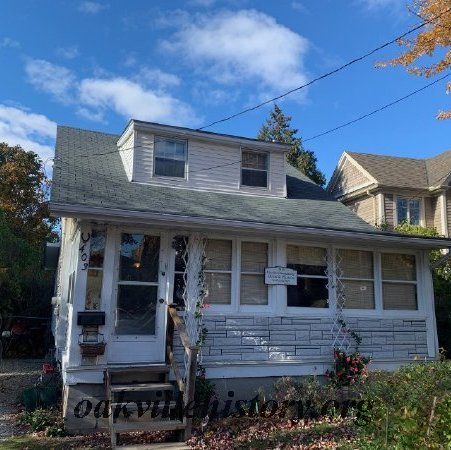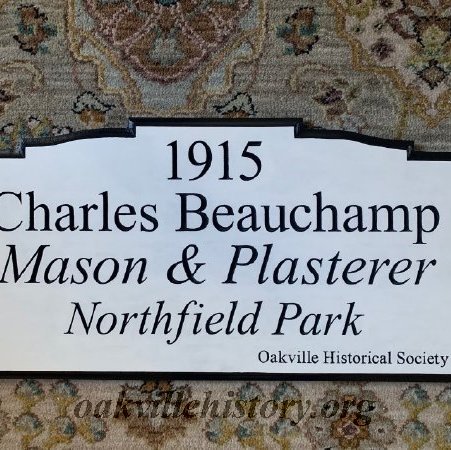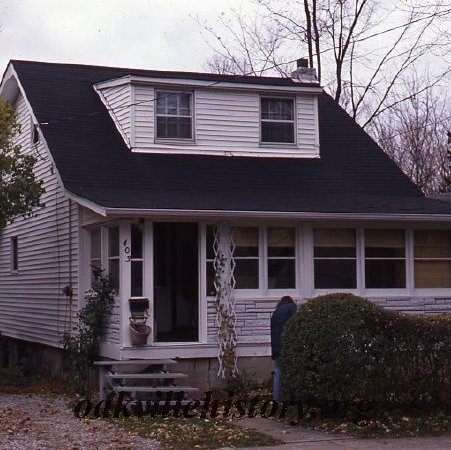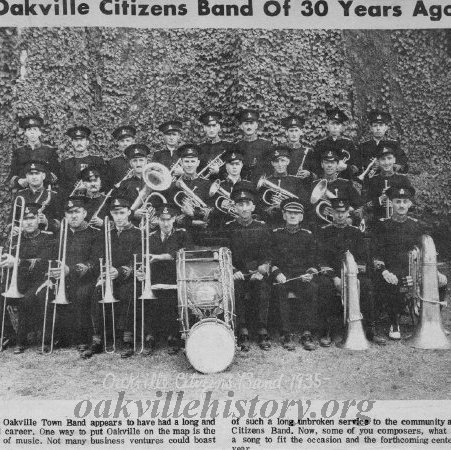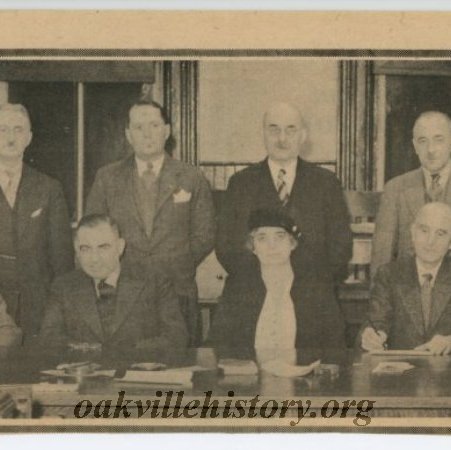Address:
403 Pine Avenue - The property of Charles Beauchamp and Alice Mary Ingrouille
Summary:
Charles Beauchamp purchased the lot for this house on November 26, 1912 for $150. The property, with an unfinished house on it, was sold on April 1, 1915 to Charles Haddlesey, who married Helen Inglis in 1920.
Property Details:
This house, located at 403 Pine Ave., is at the very north end of what was first known as the subdivision of "Tuxedo Park". It is part of a large lot identified as "#123", consisting of 5 acres bordered by Pine Ave, Allan St, Watson Ave, and another lot to the north. Interestingly, beginning in 1915, this large lot became known as "Northfield Park" according to the tax assessment records and remained so well into the 1920's.
Tuxedo Park was created in 1910 on land owned by Louis Philip Snyder. In 1912, he began selling off portions of Lot 123 which had been further subdivided and identified by letters. On 29 Nov. 1912, he sold lot W to Charles Beauchamp, a mason and plasterer, for $150. Charles Beauchamp was born in St Peter Port, Guernsey in 1879. Over the course of the next couple of years, Beauchamp began building the house, but by 1914 it was still "unfinished". On April 1st of the following year, the lot was sold to Charles Haddlesey. Beauchamp had enlisted in the 76th Battalion of the Canadian Expeditionary Force in September 1915 at Georgetown. His service records indicate that he had served for four years in the Guernsey Light Infantry and had a wreath and anchor plus a pot of flowers tattooed on his left arm. On his right arm he had a Union Jack, a sailor and "True Love". He listed his wife, Alice L Beauchamp a his next of kin. In 1916, at Shornecliffe Camp in England, he was declared unfit for further military service because of hearing issues aggravated by service. He was discharged back to Canada and died in 1959. He is buried at St Jude's.
Charles Haddlesey was also a builder who had purchased several lots from L. P. Snyder in Tuxedo Park with a view to building homes on the lots and selling them. This he did with his brother Thomas. This is when tax assessment records indicate that the house was finished.
Charles Haddlesey was born in 1889 to parents John & Mary and had five siblings. In 1902, tragically, their mother died, and John was left to raise the children. Two of Charles' older siblings, William & Edward remained in England, while the others; Lewis, Thomas and Beatrice emigrated to Canada along with Charles. It is clear that things weren't going well for the Haddlesey family, as Thomas, aged 15, arrived in Oakville under the care of Dr. Barnardo's Children's Homes in February 1907. Charles arrived on his own the same year at the age of 18. Beatrice emigrated in 1911 as a domestic and Lewis in 1913.
With the First World War upon them, Charles and Lewis made their way to Toronto to enlist. While Lewis was accepted, Charles was turned away due to his poor eyesight. This did not sit easy with Charles, as he was to explain years later in the book "Poor Bloody Murder: Personal Memoirs of the First World War": At that time all the girls were going around with white feathers. They'd stick one of those feathers on you if you were not in uniform. My brother and I went to enlist near the end of August 1916. The army took him, but they wouldn't take me. I went back to the recruiting office and complained to them, "Gosh, You walk down the streets here and somebody sticks a feather on you". The Lieutenant there said to me "Do you want to go that bad?" I said, "Sure I do. My brother is going and I want to go with him." He said, "You be at the docks, take the boat to St. Catharines, go to a certain hotel in St. Catharines and I'll be there. I'll take you to a doctor that will pass you." That's how I got in."
Charles' eyesight was so poor, he never did make it to the front. His brother Lewis did though, but unfortunately, died accidentally when struck by a motor wagon in December 1916. While Charles was away at war, Thomas remained to care for the various properties.
After the war, In 1920, Thomas married Stella Perry, and the same year, Charles married Helen Inglis. Helen became the first woman to serve on the Oakville Council in 1936 and 1937. They had two children, Lewis and Norman.
In 1923, Haddlesey sold the lot to Elizabeth Lewis, a widow. However, tax assessment records indicate that Charles & Elizabeth Lewis had been living there since 1919. After Charles' death in 1920, Elizabeth resided there until 1944 at which time she sold it to her son Charles Llewellyn Lewis for "Love plus $1.00. She died a couple of years later.
Helen Haddlesey died in 1974 and Charles died in 1984 at the age of 95. They are both buried at St. Jude's Cemetery.
Tuxedo Park was created in 1910 on land owned by Louis Philip Snyder. In 1912, he began selling off portions of Lot 123 which had been further subdivided and identified by letters. On 29 Nov. 1912, he sold lot W to Charles Beauchamp, a mason and plasterer, for $150. Charles Beauchamp was born in St Peter Port, Guernsey in 1879. Over the course of the next couple of years, Beauchamp began building the house, but by 1914 it was still "unfinished". On April 1st of the following year, the lot was sold to Charles Haddlesey. Beauchamp had enlisted in the 76th Battalion of the Canadian Expeditionary Force in September 1915 at Georgetown. His service records indicate that he had served for four years in the Guernsey Light Infantry and had a wreath and anchor plus a pot of flowers tattooed on his left arm. On his right arm he had a Union Jack, a sailor and "True Love". He listed his wife, Alice L Beauchamp a his next of kin. In 1916, at Shornecliffe Camp in England, he was declared unfit for further military service because of hearing issues aggravated by service. He was discharged back to Canada and died in 1959. He is buried at St Jude's.
Charles Haddlesey was also a builder who had purchased several lots from L. P. Snyder in Tuxedo Park with a view to building homes on the lots and selling them. This he did with his brother Thomas. This is when tax assessment records indicate that the house was finished.
Charles Haddlesey was born in 1889 to parents John & Mary and had five siblings. In 1902, tragically, their mother died, and John was left to raise the children. Two of Charles' older siblings, William & Edward remained in England, while the others; Lewis, Thomas and Beatrice emigrated to Canada along with Charles. It is clear that things weren't going well for the Haddlesey family, as Thomas, aged 15, arrived in Oakville under the care of Dr. Barnardo's Children's Homes in February 1907. Charles arrived on his own the same year at the age of 18. Beatrice emigrated in 1911 as a domestic and Lewis in 1913.
With the First World War upon them, Charles and Lewis made their way to Toronto to enlist. While Lewis was accepted, Charles was turned away due to his poor eyesight. This did not sit easy with Charles, as he was to explain years later in the book "Poor Bloody Murder: Personal Memoirs of the First World War": At that time all the girls were going around with white feathers. They'd stick one of those feathers on you if you were not in uniform. My brother and I went to enlist near the end of August 1916. The army took him, but they wouldn't take me. I went back to the recruiting office and complained to them, "Gosh, You walk down the streets here and somebody sticks a feather on you". The Lieutenant there said to me "Do you want to go that bad?" I said, "Sure I do. My brother is going and I want to go with him." He said, "You be at the docks, take the boat to St. Catharines, go to a certain hotel in St. Catharines and I'll be there. I'll take you to a doctor that will pass you." That's how I got in."
Charles' eyesight was so poor, he never did make it to the front. His brother Lewis did though, but unfortunately, died accidentally when struck by a motor wagon in December 1916. While Charles was away at war, Thomas remained to care for the various properties.
After the war, In 1920, Thomas married Stella Perry, and the same year, Charles married Helen Inglis. Helen became the first woman to serve on the Oakville Council in 1936 and 1937. They had two children, Lewis and Norman.
In 1923, Haddlesey sold the lot to Elizabeth Lewis, a widow. However, tax assessment records indicate that Charles & Elizabeth Lewis had been living there since 1919. After Charles' death in 1920, Elizabeth resided there until 1944 at which time she sold it to her son Charles Llewellyn Lewis for "Love plus $1.00. She died a couple of years later.
Helen Haddlesey died in 1974 and Charles died in 1984 at the age of 95. They are both buried at St. Jude's Cemetery.
